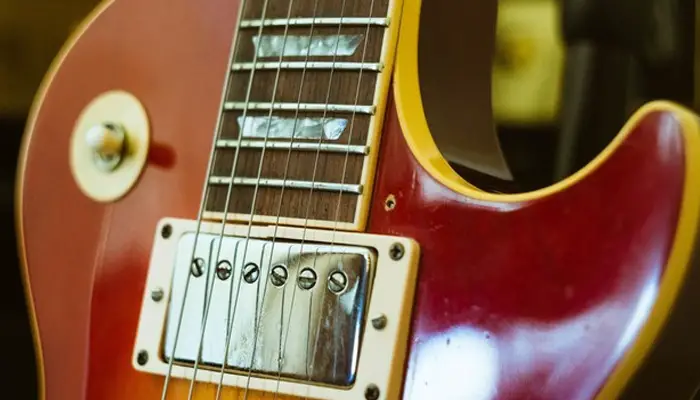
The guitar is one of the most popular instruments in use. Some instruments are in use in a specific region only. On the other hand, the guitar is somewhat universal, and most people are aware that it is a string instrument with a certain number of strings.
So, how many strings does a guitar have? Most people would say 6. However, this is isn’t always the case.
If you wish to know ‘how many strings does a standard guitar have,’ keep reading this article for a more detailed insight into the various varieties available.
It is true that initially, most guitars had six strings fitted by default. However, this is not a standard arrangement. They have evolved based on players’ innovative techniques and discoveries. Now, they come in various arrangements.
If we talk about acoustic guitars, they can have up to twelve strings attached. A bass guitar can have arrangements of five, seven, eight, nine, twelve, and thirty-six strings. Electric guitars have arrangements of seven, eight, nine, ten, twelve, eighteen, and even twenty strings. Let’s discuss this in detail in the following sections.
WHAT IS A GUITAR STRING?
With so much talk about guitar strings, if you’re relatively new to guitar playing, you must be wondering what they are? Before diving into discussing how many strings do guitars have, let’s quickly discuss what a guitar string actually is.
A guitar string is a medium through which musicians express their art- the art of guitar playing. It is the most essential component of a guitar. It is also the most fragile component-easily breaking and making your guitar useless. Not to worry, though- it can be replaced at the repair shop rendering your guitar ‘good as new.’
The standard guitar has six strings. The strings are numbered as 1, 2, 3, 4, 5, 6. These strings may be bare or wound. Numbers 1 and 2 are wound or bare, while numbers 3,4,5,6 are wound strings only.
So what is the purpose of a guitar string? To produce a musical note which, when improvised, creates beautiful pieces that we love to listen to!
The anatomy of a guitar string is complex yet fascinating for the user. It consists of
- A CORE WIRE :
The core is usually hexagonal-shaped or round-core.
- WINDING- A thin wire wound around the core wire. They may be round wound, flat wound, or half-round. A standard guitar is coated with a string.
- COATING OF STRING: The string usually has a layer made of plastic polymer. Coated strings are a bit pricey as they offer the quality of lasting longer.
- DIFFERENT GUITARS WITH DIFFERENT NUMBER OF STRINGS
As discussed, there are various guitars available in the market, each with its own characteristic features.
- ELECTRIC GUITARS
If you’re curious to know how many strings are there on an electric guitar, this section is very comprehensive about it. Usually, there are six strings on an electric guitar by default, i.e., factory arrangement. While six strings are the standard for an electric guitar, this is not fixed.
With more advancements and variety in the market based on customer feedback, they now come in arrangements of six, seven, eight, nine, ten, eleven, and even twelve strings!
As the number of strings increases beyond seven, you can play lower notes too. A 12- string guitar can provide thicker overtones.
Other than this, another option is double, triple, and quadruple neck electric guitars.
The most common configuration among electric guitar players is a double-neck guitar with a six or twelve string arrangement.
You can look for an electric guitar of your choice using this link
- BASS GUITARS
Unlike other configurations, the bass guitar typically has four strings by the default factory setting. With recent innovations among bassists, there has been a variety in the configuration.
If you’re wondering, ‘how many strings does a bass guitar have?’ The answer to that is that they are now available in configurations of five, six, seven, eight, nine, twelve, and thirty-six strings as well!
You can look for a bass guitar of your choice on amazon using this link
- WEIRD GUITARS
Because of their peculiar arrangement of strings and overall shape, they are known as weird guitars. If you’re wondering how many strings does a weird guitar have, they’re usually 7-stringed with the 7th string located to a B note, usually as a low string.
You can look for a weird guitar of your choice on amazon using this link
- SEMI-ACOUSTIC GUITARS
‘Semi-acoustic guitars’ also known as ‘hollow-bodied electric guitars ‘They are a combination of electric guitars and acoustic guitars in that they are hollow like acoustic guitars but thin and like electric guitars.
Because of their thin and hollow makeup, they will sound like acoustic guitars but will not produce a loud and powerful sound like them.
You can look for a semi-acoustic guitar of your choice using this amazon link
- 12-STRING ACOUSTIC GUITARS
If we ask you, ‘how many strings does a typical acoustic guitar have?’ Your answer would be 6. There is a 12-string acoustic guitar arrangement too.12-string acoustic guitars are tuned as sets of 2 ‘sixes’ and in octave, so they produce thicker overtones. They may be made of wood or metal. They are pretty simple to play and can be used by beginners but not by those playing heavier and more intense music genres.
You can look for a 12-string acoustic guitar of your choice using this amazon link
- ACOUSTIC-ELECTRIC GUITARS
These are one of the coolest guitars out there. They have an in-built microphone in them to be plugged into the PC, and music can be transferred. An acoustic-electric guitar can be linked to an amplifier to amplify the sound. This instrument is ideal for live shows.
You can look for an acoustic-electric guitar of your choice using this amazon link
- ACOUSTIC GUITARS
If you’re wondering how many strings does an acoustic guitar have, this section will give you a good insight into it.
Like most guitars, an acoustic guitar has six strings by default factory arrangement. While that is a standard, it is not fixed, and acoustic guitars can be customized to have six, seven, eight, nine, ten, eleven, and even twelve strings!
Like electric guitars, a twelve-string configuration for acoustic guitars provides a thicker overtone, I.e., they are tuned in octave.
You can look for an acoustic guitar of your choice using this link
- DIFFERENT TYPES OF GUITAR STRINGS:
Now that we’ve touched on the topic of ‘how many strings does a guitar have?’ Let’s look into the variety of guitar types available in the market.
Guitar strings are made of many materials. These include Brass, Bronze, Steel, nickel, nylon, etc. Let’s take a deeper dive into the merits these metals and alloys have to offer in tuning a guitar.
- BRASS AND BRONZE
BRONZE: bronze guitar strings are a great choice as they are pretty shiny and appealing. Bronze is an alloy of copper and tin. Compared to phosphor bronze, classic bronze is quite bright and is also great at preventing corrosion.
BRASS: Brass is also referred to as 80/20 bronze and compared to bronze, it more appealing and shiny. It is known as 80/20 bronze as it is an alloy of copper and tin in the ratio of 80: 20
- STEEL AND NICKEL
STEEL: The use of stainless steel as the material for guitar strings is quite popular due to its endless advantages. The most obvious one being its corrosion resistance. This is an ideal quality for regular users as it will avoid corrosion due to sweaty hands and have it last longer. It also has a shiny luster compared to other varieties making it more appealing to use.
NICKEL: If you’re using pure nickel as material for your string, it will give a softer and warmer tone to your guitar. This will provide a more vintage vibe to your music. They balance the harshness that may be there in the tuning. Nickel-plated strings sound great and are a must-have!
NICKEL-PLATED STEEL:
These are the most popular variety of electric strings. They are available in a variety of sizes and numbers of strings. They give a smooth yet catchy sound to the guitar that is incredible. Most electric and bass guitars have nickel-plated steel wrap wire.
- NYLON STRINGS
Nylon strings are used on classical guitars. These guitars are more compatible with a light string-like material such as nylon compared to steel plated strings as they are fragile and lightly fixed.
- How Many Strings Does a Bass Guitar Have?
Most bass guitars have four strings by default. This 4-string configuration has the tuning of the following notes: EADG. It is also appropriate to say that bass guitar is the guitar with most strings. A 36 string arrangement is also available.
- 5-String Basses:
Five-string basses have additional B notes below the E note. It is pretty flexible as it can give you access to lower letters while also giving the flexibility of drop tuning – dropping the bass as used by more dense genres.
- 6-string basses:
a 6-string configuration is similar to a five-string configuration, but an addition of a C note is there above the G note. In more complicated genres such as jazz, 6-string basses are a real help.
- 7-String Basses
7-string basses have the tuning of the following notes: BEADGCF.7-string basses are less common compared to others but still used.
- 8-String Basses
This is mainly a 4-string bass with two sets of strings. Usually, a 12-string guitar has two sets of strings, and that helps achieve thicker overtones. The same is the case with 8-string basses.
- 9-String Basses
With 9-string bass, you get good contrasting highs and lows to change up the music.
- 12-String Basses
12-string basses provide three sets of strings in 4’s. The high and low notes are great.
- 36-String Basses
36-string basses have four necks. While they look fascinating and cool, they are not that practical. This is by far the most strings on a guitar.
- How Many Strings Does A Classical/Acoustic Guitar Have?
An acoustic guitar is a classic guitar with a 6-strings set. While this is the standard guitar if you’re wondering how many strings does a classical guitar have? Don’t just stop at 6-strings. There is a variety in the configuration.
- 12-String Acoustic Guitars
12- String acoustics have two sets of strings in sixes. This provides good flexibility in the highs and lows they have to offer.
- Harp Guitars
Harp guitars are made up of 2 components- a six-string guitar and a six-string harp. So in total, they have 12 strings but with some changes compared to the classic guitars.
The harp part of this guitar is similar in working to a bass guitar.
- How Many Strings Does An Electric Guitar Have?
A standard electric guitar has 6–strings. A variety of configurations is now available. Let’s take a quick look.
- 7-String Electrics
7- String electrics have an addition of low B notes under the E note. These are important for heavier genres in which musicians use drop tuning.
It should be kept in mind, though, that it also provides the flexibility of switching to low notes.
- 8-String Electrics
8-string guitars are tuned with the following note arrangement: F# BEADGBE.
- 9-String Electrics
9-string guitars have the addition of a C# under the F# note. It is excellent for heavier genres.
- 10-String Electrics
Ten string- electrics sound like a hybrid between bass and guitar. It is excellent for heavier genres.
- 12-String Electrics
12-string electrics, like other 12- string guitars, are two sets of sixes and provide thicker overtones since they are tuned in octaves.
- 18-String Electrics
With more innovative and advanced techniques of playing the guitar being displayed by musicians, 18-string electrics have also been invented. While they are challenging to play, they can be mastered with the right techniques.
- 20-String Electrics
Like the 18-string electric guitar, this is quite complex, but once mastered, it is fascinating to watch a musician play it.
- CONCLUSION– How Many Strings Does a guitar have?
So, a good variety of different guitars such as acoustic, bass, and electric guitars are available that suit different genres of music. Among these, a variety of other string arrangements and materials used to develop these strings is available.
It is both fascinating and confusing to deal with such an incredible variety within a single instrument. This gives musicians the flexibility to choose which instrument and arrangement suites them and their music.
So, in the end, the question isn’t really ‘ how many strings does a guitar have’ but more about what configurations work for you.
‘how many strings on a guitar is very relative as the market has an endless variety to choose from. Hopefully, this article has provided a comprehensive guide on the characteristics of each type.


